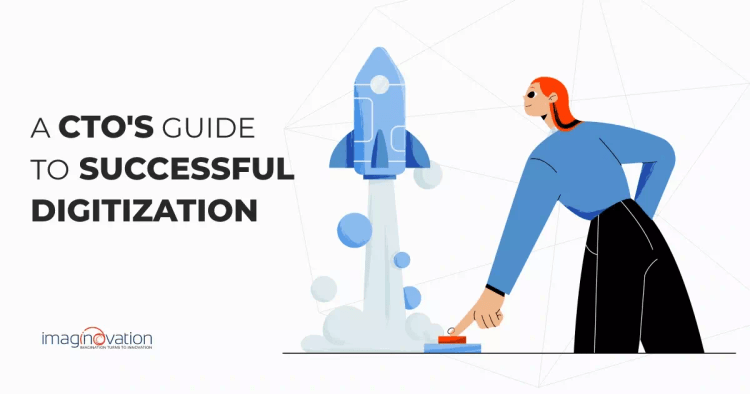The pandemic unleashed chaos at its onset. On the brighter side—it brought in positive facets, such as proactive energy and innovation. Along with everything else, there was a new C-suite position that became popular, a different CTO: the Chief Transformation Officer.
Today, the role of the chief transformation officer is deeply relevant. The portfolio takes care of the transformation needs of a future-fit enterprise.
It’s a beautiful opportunity to leverage cutting-edge technology to accelerate the organization's ambitions. What’s needed is a change in the organization's mindset to optimize the CTO’s role.
If you’re wondering how a CTO can leverage digitization efforts to achieve phenomenal success, let’s find out!
Who is Called The Chief Transformation Officer, and Why?
Firstly, the relatively new-kid-on-the-block Chief Transformation Officer (CTO) should not be confused with the Chief Technology Officer. The executive role is new and is a variant or extension of the CEO’s office.
The role thus focuses on bringing in changes and growth in revenue and profit to your organization, and we will touch upon this in detail.
Moreover, CTOs can navigate through developments in technology brilliantly. Plus, they can plan and steer the organization through changing markets, competitive environments, trends in international trade, and customer demands.
The CTO brings many benefits to the table for your business ecosystem. And with specialized expertise, the business leader can facilitate global business transformation.
Ultimately, the CTO acts as the face of the change in the organization and sets the tone, spurs enthusiasm, and modernizes outmoded processes.
When Does a Company Need a Chief Transformation Officer?
Picture this! You have a transformation program in a blueprint. However, somehow the execution isn’t quite delivering the results you’d hoped for.
You are also worried about shrinking profits, lost market share, and reduced competitive advantage. Plus, you want someone to deal with the volatility of the market.
Enter - Chief Transformation Officer (CTO)! Your one-word answer to make the transformation program into a phenomenal reality could be a CTO. The executive role has a plethora of benefits in stow for your organization.
The executive helps deliver transformation programs committed to the Street or equity investors. Of course, one won’t find every company that engages in transformation looking out to onboard a CTO. There are plenty of options, focusing on functional leadership or even employing a consulting firm.
So, does one need a CTO? or when do you need a Chief Transformation Officer? Before we dive in, let’s look at this exciting statistic.
BCG’s Office of the Chief Transformation Officer (CTO) helps companies defy the odds by placing the right individuals at the heart of their most ambitious change efforts. When a CTO is onboarded, the transformation success rate improves by 80%.
In light of the statistics, it may be worth considering onboarding a CTO to achieve your digitization initiatives and more.
Top Reasons When You Need a Chief Transformation Officer:
- Improve and facilitate collaboration: There is a need to improve and encourage collaboration. Plus, it would help if you had a mentor and problem-solving expert who could help the organization streamline productive collaboration between subordinates. The executive could help with delegation, problem-solving, finance, and operations management.
- Stress on centralized transformation office: The CEO is stretched, and one could use the focus of a centralized transformation office.
- Augment global business transformation initiatives: Another facet is that the organization decides to have a specialist facilitate the global business transformation initiatives. Plus, there are many other key initiatives that you’d want to drive across functions and business units.
- Work closely with Chief Innovations Officer: There is a need for an executive to work closely with the Chief Innovations Officer to manage the process of innovation and change management.
- Take care of the company’s external communications responsibilities: Furthermore, the company needs someone to take care of the responsibilities of external communications, such as informing the vendors on the change policies, working with affiliate companies to ensure equal implementation of changes, cooperating with partners who contribute to the change management process.
The Role of Chief Transformation Officer

With businesses evolving rapidly, the new C-suite role is gaining popularity. The role of the CTO varies depending on the scale of the company. Plus, it depends on the nature of the transformation that the executive is responsible for.
For example, when we look at smaller companies, the CTOs here will want to focus on local and regional development. However, for larger companies, the CTOs role encompasses a business transformation focusing on Finances, HR, Legal, Compliance spheres, and an emphasis on the need to increase global presence and grow international profits.
Here’s a quick round-up of the CTO roles and responsibilities.
Chief Transformation Officer's Responsibilities
- Being an autonomous thinker: The CTO with vast experience can seamlessly drive the journey of transformation. So, one can expect the executive to single-mindedly move the organization forward, inspire employees, and act as a role model to encourage and embed change.
- Drive-in long-term, transformational value: The executive is responsible for bringing in short-term improvements. However, that’s not all! The CTO will also implement ideas that have long-term, transformational effects on the company. Typically, CTOs have a solid cross-functional background with various business situations and challenges during their career.
- Creating balance: At the heart of the CTO’s role is the ability to strike the right balance between short-term improvement and long-term value. Plus, making sure line managers themselves take responsibility for change while ensuring they deliver results effectively.
- Being a problem-solver: CTOs are responsible for any problems that arise when working on digitizing. Plus, the executive must be able to solve issues solely based on independent analysis and real-world facts.
- Accepting facts: Talking of points, great CTOs typically base their independent analysis on facts. Business leaders have a high emotional quotient and strong interpersonal skills.
- Setting the tone and mindset: The executive sets the tone, instills passion, and challenges current outmoded processes.
- Supporting corporate culture: CTOs are expected to represent, implement, and observe the company’s corporate culture.
Critical Roles of a Chief Transformation Officer
Now, let’s have a quick round-up of the roles.
- Improving Customer Experience: It’s straightforward; the customer experience (CX) is at the heart of many businesses today. And many CTO roles have CX at the core. So, they are responsible for customer journey mapping and working on how they can engage with their consumers better. Plus, make CX smoother and deliver a better experience.
- Business Architecture and Business Modelling: One of the critical facets for orchestrating change is the ability to demystify the business model and design. The process can include internal factors like teams, job roles, and priorities. Plus includes checking out the exterior architecture, such as the competition and market structure.
- Agile Working: Most CTOs look at ways to work in a more agile way to accelerate change. The agility can be seen in facets such as working in a project management sense or simply promoting experimentation, learning, and creativity in the company culture.
- Communication, Behavior & Training: One of the top reasons that change fails is that it is assumed that it can be managed by changing structural or strategic aspects of the business. Next, it is felt that people will get on board and adopt the change.
So, here’s the thing: change is sustainable with people changing their thinking, beliefs, and behavior. Most often, that is a step that needs more fostering to drive behavior change, and for that, CTOs play a pivotal role in influencing and motivating people, resulting in sustained change.
Critical Strategies for Chief Transformation Officer to Lead Successful Digital Transformation
Picture this—your organization has worked around decades of research and poured in analytics and best industry practices. And still, many transformations are struggling!
Two reasons that contribute to transformation failures are lack of leadership commitment and resistance of the people.
So, what are some strategies that can lead to effective digital transformation?
1. Committed Leadership and Effective Strategies

Getting the first step right is often significant, which pertains to focusing on being committed to driving digital transformation.
And committed leaders are always the backbone of formulating effective strategies. One can observe that visionary leadership typically works around core basics.
For example, it starts with internalizing the "North Star" of the organization and then drafting strategies around the North Star. The step helps with holistic alignment. Plus, one can expect not to get into any hurdles during implementation at later stages.
Suggested action steps:
- Have a clear vision and rethink the ways that business is done.
- Keep innovating, experimenting, and taking risks.
- Agile leaders must be open to embracing partnership. For example, one can consider partnering with proficient digital consultants such as Imaginovation for a winning streak.
2. Culture Change and Empowering People
Setting the tone throughout the organization is essential, yet it is often ignored. It is powerful when employees understand transformation initiatives transparently. Plus, it helps them be proud of such initiatives, often contributing to them.
The chief transformation officers are responsible for driving the culture change and motivating people through a sense of belonging.
Suggested action steps:
- Make transformation initiatives more transparent and understandable.
- Encourage employees to experiment, empowering them.
- Prepare employees ahead of time.
3. Streamlining and Optimizing Processes

Imagine you are working on a task. And, you wonder that it would have been so much easier if there was a simpler or more efficient way of doing it.
Let’s take an example. With the onset of the pandemic, the first-line technicians suddenly got cut off from experts coming onsite and resolving machine malfunctions. In this case, a quick switchover to AR/VR technologies helped first-line technicians.
Now, think about how digitization or automation can help your current processes. The key to being more efficient and having that competitive edge is innovating, streamlining, and optimizing operations. Plus, bring in cutting-edge technology wherever it can help leverage productivity.
Suggested action steps:
- Transform workflows, making them straightforward.
- Introduce digitization and automation to achieve better outputs.
4. Curating Data
One of the focus points of a chief transformation officer is excelling in CX. And the best way of doing that is to understand customers, their pain points, and the business's pain points. Data collation and analysis can help in the identification. With a robust database, it is easy to work out solutions.
Suggested action steps:
- Data collation and analysis to understand loopholes and pain points.
- Data analysis for coming up with the best solutions to problems.
5. Cutting-edge Technologies
Bringing in niche technology is a critical step for the digital transformation strategy. It is always great to give thought to updating legacy systems, modernizing applications, and implementing new digital procedures.
It is also critical to adopt new-age technologies that can seamlessly fit into your digital transformation strategy, which include:
- Cloud and distributed platforms
- Data analytics and artificial intelligence (AI)
- Augmented reality and virtual reality experiences
Suggested action steps:
- Embed emerging technologies into current processes for better outputs.
- Find out the right-fit technologies as a part of the digital transformation strategy.
6. Team Structure

At the heart of digital transformation, it’s all about people, not tools. So, having the right team on board is essential.
The unit can comprise torchbearers and agile leaders, business ninjas (product managers, program managers, solution architects, and more), coders, and designers (developers, data scientists, visualizers, and more).
The end goal is to have high-performing teams. Plus, having an apt methodology, such as agile methodology, can ensure the success of the transformational change that is aligned with the forward-looking vision.
Suggested action steps:
- Team structure can map the size of the project.
- It needs to be well-balanced to achieve success in digital transformation initiatives.
7. Outstanding Results
Here’s a metaphor! If you’ve drafted ‘all left’ in your digital transformation strategy, how can everything go ‘all right.’
Dropping off the tongue-in-cheek metaphor, you must prepare the plan with thought, as the results of your company’s digital transformation will be strongly influenced by it.
Results will depend on many other facets, such as the employee technologies you choose and implement. Plus, remember to be patient to see the results, as long-term strategies take time. And also, someone needs to measure and monitor how the initiatives are constantly working.
Here, agility is the key to the success of the digital transformation strategy. So, be open to changes, and fine-tune if the system doesn’t work out the way you expected it to work.
Suggested action steps:
- Results depend on a clear and well-drafted digital transformation strategy; work on it.
- Agility is the key to success, be flexible enough to fine-tune the plan if needed.
Wrapping Up
For a successful digital transformation journey, business entrepreneurs need to focus on creating the right ecosystem.
It is time for a shift in the mindset of flexibility, agility, and speed to achieve phenomenal success in digital transformation initiatives. The time is ripe to start the journey, and great for embracing partnerships.
Partner with Imaginovation for Successful Digital Transformation
It is always good to bring in partnerships with the right ecosystem for a successful digital transformation. The partnership ecosystem can help you create the right environment where you can be creative and blend in with cutting-edge technology.
To get your organization future-ready, talk to us.
We are Raleigh's award-winning mobile and web app development company with an incredible experience developing awe-inspiring digital stories.
Let’s talk.




